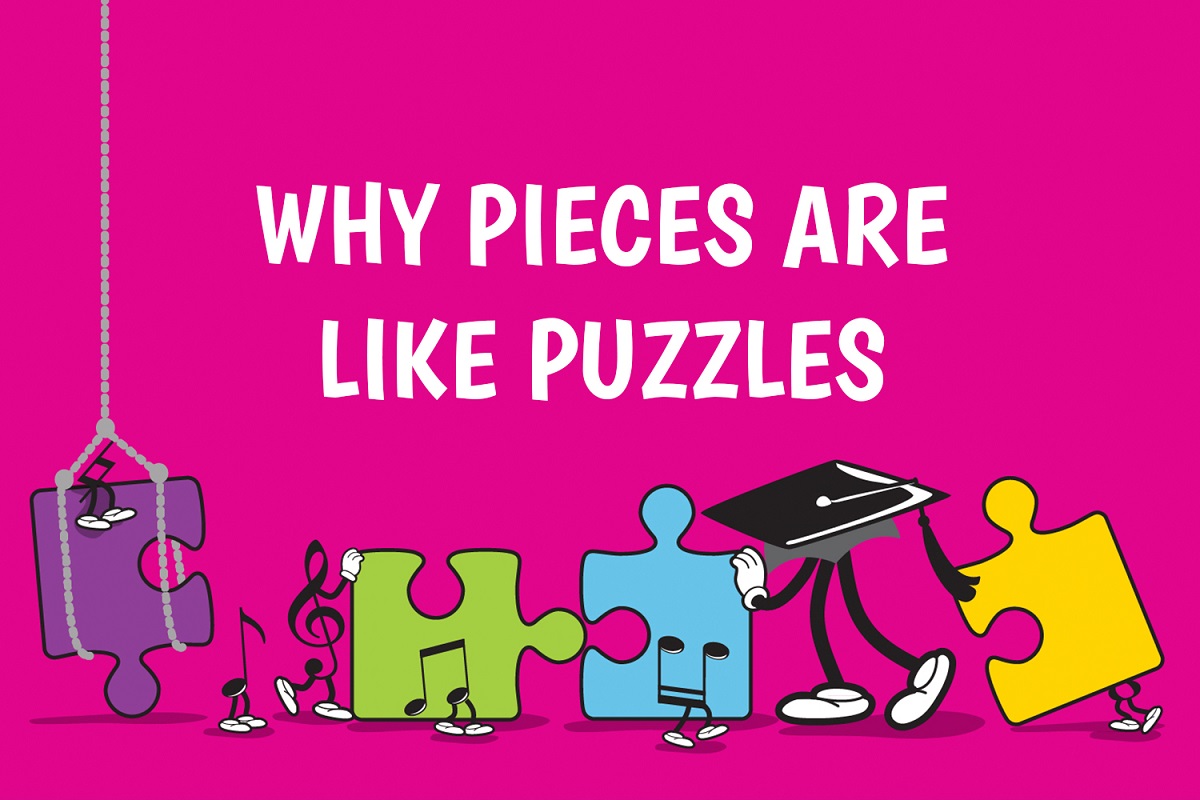Why Pieces are Like Puzzles

Piano pieces and jigsaw puzzles have many things in common. Some come together very quickly, others take a long time.
I have often used this analogy with my students, referring to their piano repertoire as a series of technical and musical challenges to solve, like pieces of a puzzle. Over the last term, however, I found more and more ways to extend the analogy. Here are some of the highlights.
Not Too Easy, Not Too Hard
If someone gave you a 20-piece puzzle, would you be motivated to do it? Probably not – that’s just way too easy – no satisfaction there. What about a 15,000-piece puzzle? That’s certainly harder – but possibly just as unsatisfying. It’s going to take too much time to finish, and you’ll have to wait too long to admire the finished product.1
This is also how you might feel about a piano piece. Too easy and you are not motivated to learn it. Same if it’s too hard. You really want pieces in the sweet spot – ‘goldilocks’ pieces, if you will – that provide a challenge but also an achievable goal.
The Big Picture
Most of the time when you do a puzzle, you are working off a picture.2 Usually, it’s a picture you like – otherwise there is less motivation to see the finished product. There are two angles to this particular part of the analogy:
- If you weren’t allowed to look at the picture, it would be much harder to do the puzzle and probably not as fun.3 In the same way, trying to learn a piece without having heard it and without knowing whether you even like it makes it much harder to learn. This is why it is so important for students to choose their own repertoire, and listen to it a lot.4 The more familiar the piece, the easier and more satisfying it is to work towards that big picture.
- Sometimes, you might absolutely LOVE the picture, but it’s a 10,000-piece puzzle that you thought you could handle and it’s taking too long and now you’re losing interest. You wish you had bought the 5000-piece version. See where I’m going here? This is equivalent to needing an easier arrangement of a piece. You get to enjoy the same picture/sound, but you won’t lose interest and you’ll get there in the end.
The Unattended Puzzle
Often you don’t have time to complete a puzzle all in one sitting. It stays out on the table for days or weeks at a time.5 Perhaps it gets moved to a corner and forgotten about. When this happens, the puzzle gets knocked around, the border comes apart, bits get lost or broken. This takes time to repair and re-do – if only it hadn’t been so neglected, this would not have been necessary!
This is what happens to pieces that don’t get practised frequently enough. The parts you achieve will fade from your memory and won’t stick around in your fingers, even if they’ve previously been perfected.
Just like a puzzle needs to be in a prominent place where it won’t get neglected, practice sessions need to be a prominent part of the weekly schedule. If you visit pieces/sections regularly enough, the piece doesn’t fall into disrepair.
Fitting it all together
If you sat down to do some of your puzzles, and say after 20 minutes you still haven’t managed to find one piece to fit, how would you feel? A little frustrated perhaps? Less keen to continue? (One thing you probably would NOT do is to pull apart the parts of the puzzle you’ve already done and re-do them. This would be pointless, wouldn’t it?6)
When there is little or no progress in a practice session, it can make you feel like you want to ditch the piece, because you’re not improving. This is why it’s important to have strategies.
Lots of people have strategies for doing puzzles: doing the border first, finding certain shapes, separating out certain colours. Often there are clumps of the puzzle completed here and there, and gradually it all comes together.
Similarly, you need strategies for learning pieces: things like playing slowly, going over problem areas, perhaps learning sections hands separately. It’s going to be a while before it all comes together and sounds like a ‘piece’.
One small extra point about this: good quality puzzles have pieces that fit together beautifully. Well-arranged pieces fit comfortably under the hand. Cheap puzzles are like bad arrangements, and end up being frustrating.
How About You?
There are certainly more ways in which this analogy can be extended. I’d love to hear from you and know what comparisons spring to mind for you and your students, in terms of how you go about solving puzzles!
- Assuming you even have room for a puzzle this size in your lounge room.
- Yes I know there are those monster puzzles which are all one colour or something… they’re for puzzle nerds.
- Having said that, there are people I know who like to not look at the picture… more puzzle nerds.
- I know many teachers who say there is a ‘danger’ that students will learn the piece by ear and not read the music. There is no danger here. This is not something we should be discouraging. But that is a whole other blog post.
- Or months if it’s one of those 15,000-piece monsters
- Yes, that’s right – this is the equivalent of only playing the bits you know already.

Your blogs always make me think! I love that! By chance, have you done “a whole other blog post” to address #4, “the danger” that students will learn by ear and not read music? I am very curious about that! Thank you!
Hi Jean, I haven’t yet blogged about that one… but if you subscribe you’ll be notified when I do!!! 🙂